| Manufacturer: | Neubauer Rockets  |
![[Picture]](/images/archive/images/ratings/rating_nb_super_tube.gif) (07/26/03) Remember the old Estes Broadsword? Remember how
"big" it was to fly on the mighty "D" motor? Remember how
slow and majestic the flights where? Add 11" more inches of height, give
it a unique, never-been-seen-before nose cone, and swap out those four big
balsa fins for 6 tube-fins and you now have the Neubauer Super Tube!
(07/26/03) Remember the old Estes Broadsword? Remember how
"big" it was to fly on the mighty "D" motor? Remember how
slow and majestic the flights where? Add 11" more inches of height, give
it a unique, never-been-seen-before nose cone, and swap out those four big
balsa fins for 6 tube-fins and you now have the Neubauer Super Tube!
I bought this 47" long, 2.6" diameter rocket primarily because of its unique nose cone and tube fins. But after building and flying it, it really reminded me of the old Broadsword. The kit is simple and building it is simple, too.
 The kit includes 3 sections of 2.6" body tube
(thin), 2 couplers, a balsa nose cone, and (6) 5 3/4" long tube-fins. The
motor mount is like an Estes mount for 24mm motors but uses an 18" motor
tube, a retainer clip, thrust ring, and two basswood (?) centering rings. The
recovery system includes 58" of ¼" elastic shock cord, an
eye-screw for the nose cone, and a plastic 27" parachute that you
assemble. There are no decals.
The kit includes 3 sections of 2.6" body tube
(thin), 2 couplers, a balsa nose cone, and (6) 5 3/4" long tube-fins. The
motor mount is like an Estes mount for 24mm motors but uses an 18" motor
tube, a retainer clip, thrust ring, and two basswood (?) centering rings. The
recovery system includes 58" of ¼" elastic shock cord, an
eye-screw for the nose cone, and a plastic 27" parachute that you
assemble. There are no decals.
CONSTRUCTION:
The instructions are printed on both sides of a single 8½ x 11" sheet of paper. They include illustrations and a fin marking guide. It is an easy rocket to assemble, so nothing more is needed.
Assembly starts with the motor/stuffer tube. The thrust ring is inserted to allow for Estes D motors and the motor hook is the same. One of the centering rings then requires you to notch it for the motor hook. I had to sand the inside of my centering rings a bit to get them to fit. They are a soft wood, but not balsa, so I think basswood. The upper centering ring is placed into the first section of the body tube to allow the 18" motor tube to act like a stuffer tube.
Next the three sections of 2.6" body tubing are assembled. The first coupler is placed against upper centering ring and then the lower section of the motor mount is installed. The coupler between the middle and upper sections of the body tube is used to hold the shock cord. The shock cord is tied around the coupler and then the coupler is glued in place.
The tube-fins are made into 3 pairs and then each of the pairs are glued into place on the lower section of body tube.
The launch lug is then aligned with one of the gaps between two tube-fins and glued into place.
Lastly the parachute needs to be assembled using the provided shroud lines, clear packing tape and the parachute.
That's it, and as Neubauer says in their last step, Step 13, "Paint rocket to your liking." So I did.
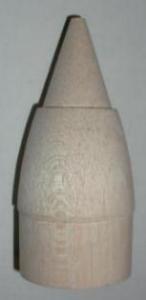
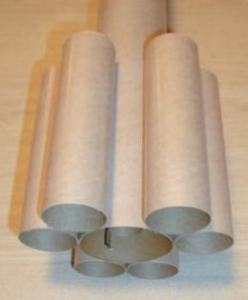
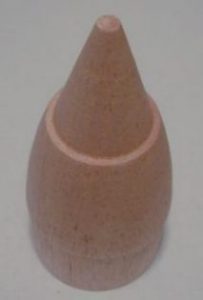
For finishing, I used several coats of Plasti-Kote primer to fill in all the seams on the tubes. I also needed to concentrate on the balsa nose cone and its unique design. I then just used three different colors of Kylon paint I had. I'm trying to use up all my paints before buying an new.
Overall, for CONSTRUCTION I would rate this kit 3 ½ points. The instructions are clear and easy to follow. The thin body tubes scare me, but then again, they are just like the old Estes Broadsword. They may also be a good choice to keep the weight down to allow flights on the D12 motors. I had to do a bit of sanding to make parts fit. The nose cone is very unique-looking and I venture to say, "cool". There are no decals provided with the kit.
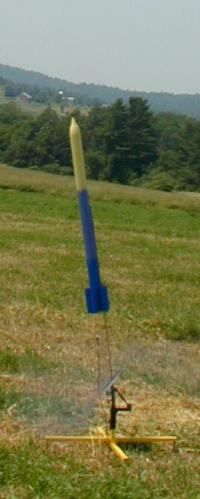 FLIGHT/RECOVERY:
FLIGHT/RECOVERY:
Neubauer recommends the D12-3, E30-4, or the E28-4 (RMS). They also indicate that the rocket should weight 11 ounces. My finished rocket, with a piece of Nomex weighed in at 11.7 ounces.
Do note that the Super Tube is a tall 24mm rocket and does require a 1/4" launch rod.
I actually choose an AT RMS D15-4 for my first flight. As I just said, instead of wadding I attached a piece of Nomex® Heat Shield from Pratt Hobbies to the shock cord to protect the 'chute. The nose cone needed some tape to sit snug, otherwise it was very loose.
With a bit of wind, between 5 and 10mph, I put the Super Tube up for its first flight. Like the old Broadsword, lift-off was slow and graceful. As it turned at apogee, it seemed so large (all respective) and kind of hung there. Ejection fired, making the nose cone "pop" out of the tube and the 'chute deployed. It drifted a bit with that large 'chute and was recovered. One of the bottom tube-fins suffered some slight damage; it was bent in. I bent the tube-fin back out and decided to fly it again another day.
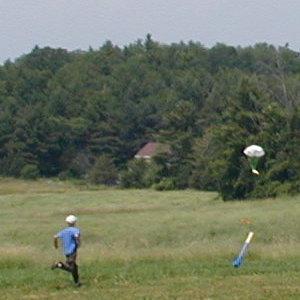 A few days later, I put the rocket up on an E11-5. Big
mistake and complicated by an extended delay. The E11 really didn't have enough
power to lift this rocket. It did get off the ground and arch over, but the 5
second delay seemed like more and the rocket started heading toward a complete
destruction. Just 15 feet, no more, off the ground the charge fired which
flipped the rocket over just in time to crash into the ground. The 'chute only
unrolled but never had time to fill. There as slight crushing damage on two of
the tube-fins. Not bad for what it was heading for!
A few days later, I put the rocket up on an E11-5. Big
mistake and complicated by an extended delay. The E11 really didn't have enough
power to lift this rocket. It did get off the ground and arch over, but the 5
second delay seemed like more and the rocket started heading toward a complete
destruction. Just 15 feet, no more, off the ground the charge fired which
flipped the rocket over just in time to crash into the ground. The 'chute only
unrolled but never had time to fill. There as slight crushing damage on two of
the tube-fins. Not bad for what it was heading for!
I bent out the tube-fins and installed a D12-3. The D12-3 works great! Buy the rocket to match it up with motor. The large 'chute in combination with the calm flying day allowed the rocket to slowly and gracefully descend. No damage. Good, all around, flight.
For FLIGHT/RECOVERY, I would rate this rocket 3 points. It is a large rocket and for those that can only fly on smaller fields and Estes motors, this is a crowd pleaser. The D12-3 is a perfect match. I wonder how it would do on an E9... probably not so good based on the E11 experience and looking over the thrust curve. The parachute is large, but it needs to be to help prevent damage to the tube fins (although 2 out of my 3 flights suffered some minor tube-fin damage). The thrust ring and motor hook are nice but limit the motor section greatly. Perhaps an AT F21 would be a good choice if the thrust ring was gone. The thin shroud lines will have troubles after a number of flights.
I give the rocket an OVERALL rating of 3 ½ points. The unique-looking nose cone and the overall size make this a nice tube-fin kit. If I were to purchase another one, I'd do some modifications to allow a wider range of motors. I would also stiffen up that tube-fins with a CA soak, or Epoxy or fiberglass. It would be nice if the rocket came with a super large stick-on decal that says, "Super Tube". Remember, Neubauer rockets are exclusively distributed by Discount Rocketry.
 |
 |